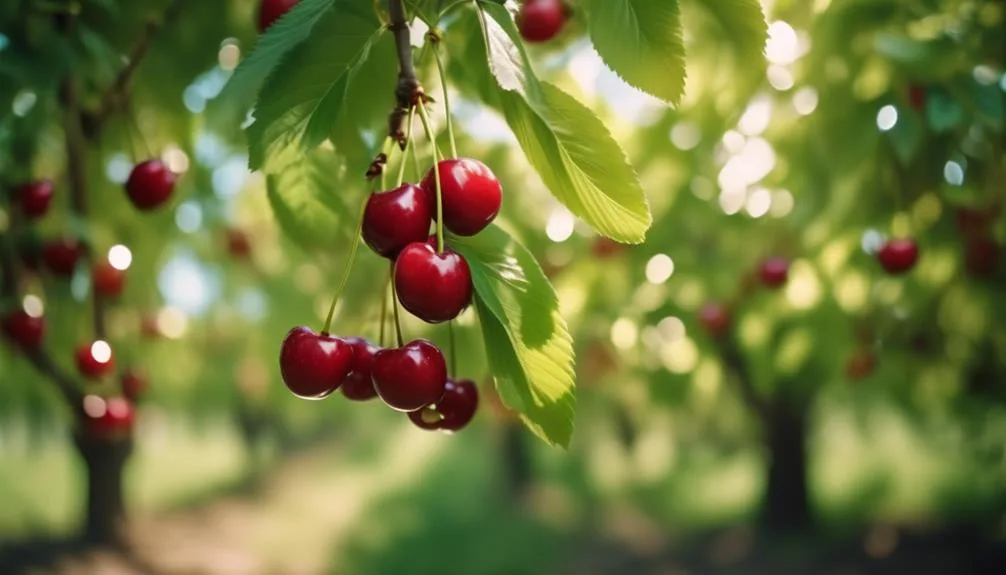Cherry trees face challenges with pests and diseases, but their resistance isn't clear-cut.
Exploring their natural defenses and best care practices reveals surprising insights into their health.
Are cherry trees truly resistant?
Let's find out.
Pests That Affect Cherry Trees
When caring for your cherry trees, you'll want to be vigilant against a variety of pests that can potentially harm your trees. Pest control is essential for maintaining the health of your cherry trees.
One common pest that affects cherry trees is the cherry fruit fly. These tiny insects lay eggs in the developing fruit, causing damage and reducing the yield. To control cherry fruit flies, it's crucial to use traps and apply insecticides at the right time during the fruit development.
Additionally, the cherry slug sawfly can also pose a threat to your trees. These pests feed on the leaves, leading to defoliation and impacting the overall tree health. Regular monitoring and timely application of appropriate control measures are key to managing these pests and preserving the vitality of your cherry trees.
Common Diseases in Cherry Trees
To maintain the health of your cherry trees, it's important to be aware of common diseases that can affect them, just as you vigilantly protect them from pests.
Fungal infections are a significant threat to cherry trees, with diseases such as brown rot and powdery mildew being particularly common. Brown rot can cause fruit rot and blossom blight, while powdery mildew affects leaves and young shoots.
Another notable disease is bacterial canker, which causes sunken patches on the bark and can lead to dieback of branches.
It's important to keep an eye out for any signs of these diseases and take preventive measures such as pruning affected branches, ensuring good air circulation, and using fungicides when necessary.
Regular monitoring and prompt action can help in managing these common diseases and maintaining the health of your cherry trees.
Natural Resistance of Cherry Trees
Naturally, cherry trees have developed various mechanisms to resist pests and diseases, contributing to their overall health and longevity. Genetic factors play a key role in the natural resistance of cherry trees to pests and diseases. Certain cherry tree varieties possess genetic traits that make them more resistant to specific pests and diseases, allowing them to thrive in various environments.
Additionally, environmental influences such as climate and soil conditions can also impact the natural resistance of cherry trees. Trees grown in optimal environmental conditions are better equipped to resist pests and diseases, as their overall health and vigor is enhanced.
Managing Pests and Diseases in Cherry Trees
Cherry trees require diligent management to effectively combat pests and diseases while promoting a healthy and bountiful yield. To manage pests and diseases in cherry trees, consider the following:
- Integrated Pest Management (IPM): Implement IPM strategies such as promoting beneficial insects, using biological controls, and employing targeted pesticide applications to minimize the impact of pests while reducing environmental damage.
- Disease Resistant Cultivars: Select cherry tree cultivars that exhibit natural resistance to common diseases, such as cherry leaf spot and brown rot, to minimize the need for chemical interventions.
- Regular Monitoring and Maintenance: Conduct routine inspections to detect pest or disease issues early, and promptly address any problems through appropriate cultural practices, pruning, and sanitation.
Tips for Maintaining Cherry Tree Health
Improving the health of your cherry trees is essential for ensuring a thriving and productive orchard. Pruning techniques play a crucial role in maintaining cherry tree health.
Regular pruning helps remove dead or diseased branches, improving air circulation and sunlight penetration. This practice also promotes the growth of new, healthy branches and encourages fruit production. When pruning, make clean cuts at a 45-degree angle just above a bud to prevent water from settling on the cut.
Additionally, establishing a proper watering schedule is vital for cherry tree health. Water deeply and less frequently to encourage deep root growth, ideally providing 1-2 inches of water per week during the growing season. Avoid shallow, frequent watering, as it can lead to weak root systems and make trees more susceptible to stress and diseases.
Conclusion
To maintain cherry trees' health, it's essential to manage and monitor potential pests and diseases. By doing so, you can safeguard your trees and promote their longevity.
Stay vigilant and proactive to ensure your cherry trees thrive for years to come.

My interest in trees started when I first saw the giant sequoias in Yosemite.
I was a teenager then, and I remember thinking, “I need to learn more about this.”
That moment stuck with me.
A few years later, I went on to study forestry at Michigan Tech.
Since graduating, I’ve worked in a mix of hands-on tree care and community education.
I’ve spent over ten years helping people understand how to plant, maintain, and protect the trees in their neighborhoods.
I don’t see trees as just part of the landscape.
They are living things that make a real difference in our daily lives.
